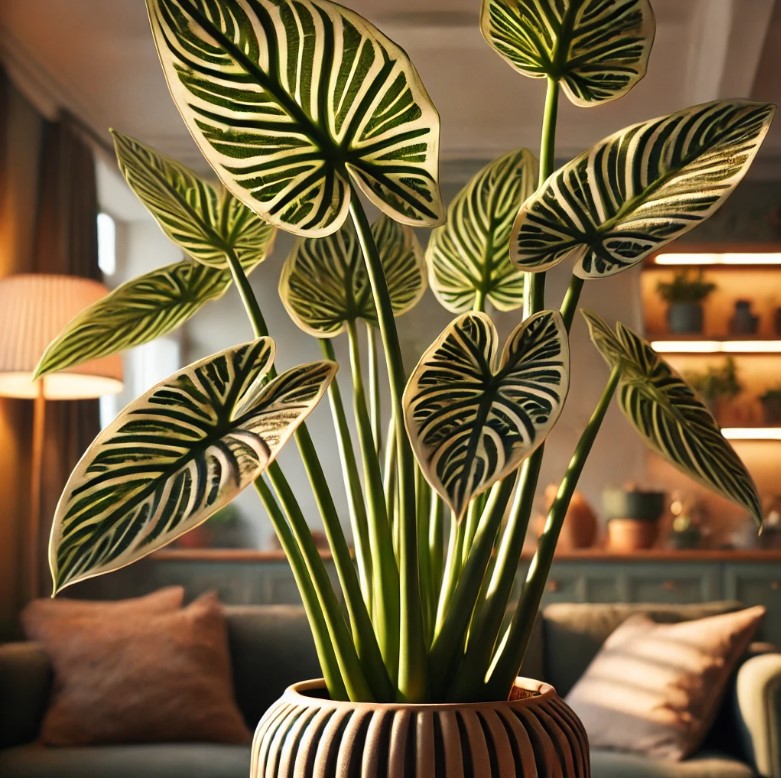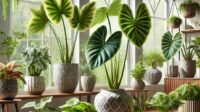
Alocasia Zebrina – Known widely as the “zebra plant,” this Alocasia variety is quite valiant and arguably one of the most rare types. This plant has become a darling of plant collectors and lovers alike with its bold near-black, zamia-like leaves that meet at the base to form an arrow shape and velvet striped stems. However, as this beautiful houseplant gains in popularity many people are asking if Alocasia Zebrina is rare. The answer is yes! The reason behind Alocasia zebrina rarity is the growing conditions are very specific for it grow right, health specimens are rare and high demand with collector’s buying them each week as they come in. We will discuss why it is such a rare plant, what determines its availability, and some things that prospective buyers should keep in mind prior to getting this gorgeous houseplant.
1. What Makes Alocasia Zebrina Stand out
Alocasia Zebrina is eye candy with its gorgeous striking appearance. The plant produces shiny dark green arrow-shaped leaves that can grow long. But its real claim to fame are the stems that look like zebra stripes of light and dark green, which is how it got its name. Leaves can reach 12 inches in length and make a statement anywhere inside. This plant is a sure hit, and these unique features make it desirable amongst interior decorators and plant collectors alike.
2. Why Alocasia Zebrina Is Rare?
Alocasia Zebrina is scarce for many different reasons. A big part of the reason why is that it’s challenging to cultivate. It has a very specific condition of growth with high humidity and warmth but never direct light. Alocasia Zebrina is also a slow-grower, which leads to limited market supply. Finding specimens with their signature zebra stripes still intact is a little challenging. They also make healthy mature plants pretty difficult to find too. This scarcity has given this plant a reputation for being a rare jewel of the plant world, often with prices to match.
3. Why Alocasia Zebrina is Popular Amongst Plant Collectors
Its exotic look, together with its scarcity have been triggering Pant enthusiasts to hunt it all down. A lot of dramatic beauty are often being shown on Instagram and plant community forums by this plant. It is also popular for its versatility with home decor. These zebra stripes on the stem are just so eye-catching that makes it a conversation piece of every room but also a touch of exotic appeal. Coupled with its rarity status — an Alocasia Zebrina is more likely to be seen as a status symbol, which puts it on the radar of collectors and plant lovers alike.
4. Alocasia Zebrina for Sale [Where to Buy]
This is hard to find but not impossible to buy. You can find Alocasia Zebrina at some specialty plant shops, select nurseries, and there are also online retailers that sell this beauty. If you are planning to purchase one, search for the reliable online plant stores that deal in rare and exotic plants. Alocasia Zebrina can also be found on plant swaps and offered by private collectors. But expect to pay a lot, both because of its rarity and the costs associated with shipping rare plants purchased online.
5. What is the price of Alocasia zebrina?
The fact that Alocasia Zebrina is rare makes it tend to be pricey. Plant prices differ based on size and take care condition. A similarly sized Alocasia Zebrina (which is generally sold as a young plant or cutting) can cost anywhere from $20 to $40. But a larger, more established plant with well-developed zebra striped stems can run upwards of $100 or higher. Then the prices of Alocasia Zebrina can change based on the demand and supply as well. Remember, this is a difficult to get plant, but with good care you could have a very valuable plant that is quite beautiful for years to come.
6. Reasons Behind Alocasia Zebrina Availability
Availability depends on a few different things for Alocasia Zebrina. The environment where the plant is grown, for example. The Alocasia is a tropical plant species, therefore the warm humid air, shade and indirect light presents a challenge to growing them outside their natural environment. Alocasia Zebrina also has a slow growth rate, so there are fewer plants available at nurseries and growers. The more popular the plant became, the rarer it became. A coveted but still hard to find plant.
7. Caring for Alocasia Zebrina
If you are wondering how to care for Alocasia Zebrina, there are a few important factors that need consideration. This plant is a warm humid climate plant, and a spot with temperatures between 60 and 80 degrees Fahrenheit is ideal. Likes indirect sunlight and should not be put in direct sun as this would burn the leaves. However, they need to be watered regularly and should never sit in water. Using a potting mix that drains well will assist in keeping the roots fresh.
8. Common Alocasia Zebrina Problems
As long as you meet the basic needs of Alocasia Zebrina, it is an easy plant to care for. But it has some issues that it is susceptible to. Too much water can result in root rot, while low humidity will make the leaves droop or turn brown at their edges. And, it is also prone to pests like spider mites and aphids that damage the leaves. Inspections for pests and adequate maintenance can prevent these.
9. Perfect Conditions for Alocasia Zebrina
As a tropical plant, Alocasia Zebrina does well in an environment that mimics its native habitat. This plant requires indirect sunlight and a temperature between 60°–80°F. It also demands a humid atmosphere but preferably between 60 to 80% humidity level. For that, you can use a humidifier or put the plant on a saucer filled with pebbles and water. Misting them on a regular basis can also ensure that you have the humidity needed.
10. Is Alocasia Zebrina Special Care?
Indeed, Alocasia Zebrina needs a special treatment to stay alive. It also enjoys being fed here and there, on top of needing the right lighting, temperature and humidity. During the growing season (spring and summer) you can provide balanced, water-soluble fertilizer to encourage healthy growth. Do not over fertilize as it will result in nutrient imbalance. Removing brown and yellowing leaves makes sure that the plant is looking fine and healthy.
11. Suitable Soil for Alocasia Zebrina
Alocasia Zebrina needs a well-drained soil mix that is moist but not soggy. Any combination of peat, perlite, and pine bark is fine for Alocasia Zebrina. Uphold acid soil to neutral (the pH of 5.5–6.5). It’s good for drainage without waterlogging the roots, which causes rot as this encourages your plant to uptake essential nutrients needed from soil.
12. How to Propagate Alocasia Zebrina
Alocasia Zebrina propagation is done via division, where the plant is divided into two or more parts, with roots attached to each. The time to do this is during spring or early summer when the plant is in growth mode. Another method for propagating Alocasia Zebrina is through stem cuttings, which is more difficult. Mind your instruments — use sterilized tools to prevent introducing diseases on the plant.
13. Alocasia Zebrina vs. Other Alocasia Varieties
Although Alocasia Zebrina is one of the most beautiful varities, but it is a type of Alocasia. Other notable types are the Alocasia Polly, widely sought after for its compact and angular leaves, as well as Alocasia Frydek, known for it’s sumptuous green velvet-like leaves. If you put Alocasia Zebrina next to these types, it is different by its striking striped stems and its eccentric look.
14. Why Do Collectors Love Alocasia Zebrina?
It appeals to collectors for its scarcity, exotic look and tricky care. Zebra stripes on its stems make one of the most beautiful Alocasia varieties as this plant have slow growth and is rarely seen in market. If youre a plant collector, an Alocasia Zebrina means more than just having another gorgeous specimen in the home garden—it represents one of the rarest of Simonas sought after species.
15. Alocasia Zebrina Buying Guide: What to Look For
When you buy Alocasia Zebrina, make sure that the leaves are healthy and stems are well developed too. Find a plant that has bright green, healthy leaves The stems should have distinctive zebra-like stripes. Don’t buy plants with yellowing or browning leaves, which can flag poor care or a bigger issue. Also, examine the roots for any indication of decay or pests before buying.
Conclusion:
Alocasia Zebrina is not just a rare beauty but it also adds an eclectic touch to your home, especially if you keep it indoors. Provided that you care for it correctly, it does well in a home environment and is not only a unique addition but also an eye-catching piece for collectors and plant lovers alike. With knowledge of how rare it is and what type of care it needs, where to buy as well as tips on how to introduce this beautiful plant into your collection with success.






